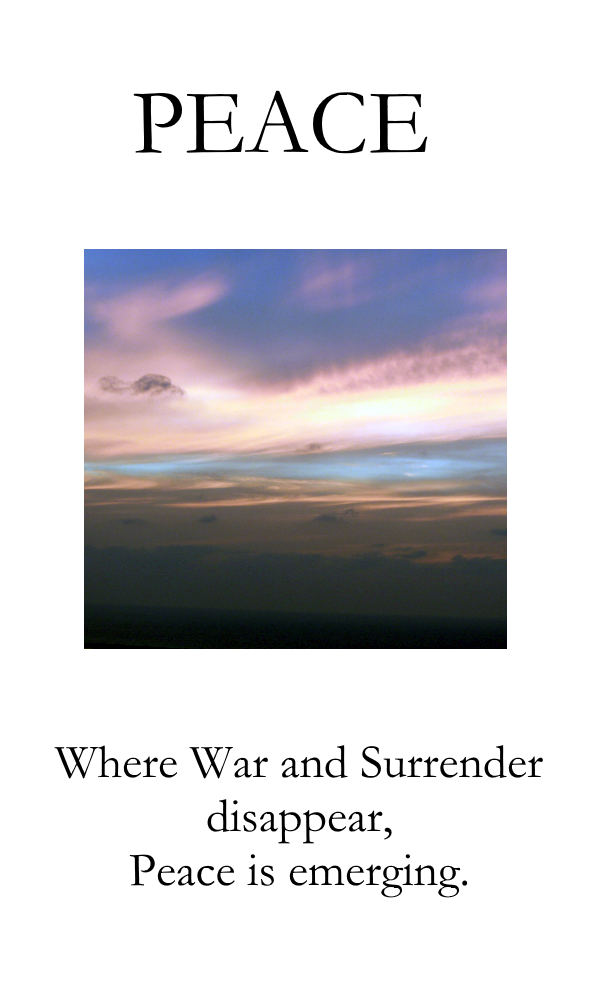“Peace is not an absence of war, it is a virtue, a state of mind, a disposition for benevolence, confidence, justice.”
Baruch Spinoza
The partner of war is surrender. Peace has no opposite. In peace, surrender and war are one.
War
The energy of war is extraordinary in that it surpasses ‘normal’ everyday experience and promotes the reversal of norms, breaking both consciously conditioned rules and ethics. In this, all psychological trauma is a kind of war zone. Trauma is an area of experience that we are unable to integrate with ‘normal’ life, including the social field and family arena. As the living experience is left outside of the ‘functioning’ psyche, it forms a sub-universe of its own, with its own game-plans and atmospheres. When we are in a trauma tunnel we can feel far away from normal life, and we can experience ourselves in a state of war with ‘normal’ life.
As humans, we have put the energetic phenomenon of war in a category of its own, with rules and laws outside of conventional ethics. As one man in a divorce said about care and respect: “That’s all very nice, but this is war.” When we are “at war”, care is frozen and conscious beliefs can flip over into their shadows. Suddenly, lying becomes an asset; cruelty a show of heroism; cynicism a virtue; and killing an act of loyalty. Theft, dishonesty, manipulation and even murder become survival assets within the basic equation of the binary mind, which is ‘kill-or-be-killed’. Rule breakers are cheered as heroes and conformists can be condemned as collaborators. There is intense pressure to take an absolute stand on one side or the other, and the consequences of that decision will continue long after the energy of war has passed.
Yet even though we might be suddenly awarded for killing or torturing fellow human beings, the commandment ‘thou shalt not kill’ still resounds through the psyche. The existential shock of violent death for the soldier is as strong as on a citizen in a time of peace. The shock of mortality and the horror of power is no less damaging to the psyche. When a divorcing couple hurt their children to win custody, they still carry the burden of hurting their children, even after the divorce is processed. The arbitrary rewriting of behavioral codes comes at a heavy and long-term cost to the human psyche. No number of medals from outer authorities can untangle the core of psychic confusion.
When we are caught within the Us Versus Them equation of war, there is an immediate disempowerment. We tend to see ourselves as victims, even when we are the stronger power. Thus, we hear statements such as that of the late Prime Minister of Israel Golda Meir: “We can forgive [them] for killing our children. We cannot forgive them for forcing us to kill their children.” While many still sympathize with the sentiment within the parameters of ongoing war, it can also be seen as exemplifying the human helplessness in taking responsibility for the lived horror that clouds all victory when the energy of war rises in the name of separate survival.
Through time, the energy of war screams from the core belief in the Separate Self and surfaces as a defense wherever there is a feeling of discomfort. The ‘other’, ‘God’, the ‘world’, ‘life’, or even existence itself takes on the form of the enemy in an unending struggle of suffering perpetuating suffering.
Surrender
The horror of guilt and the burning sensation of shame can be so powerful that we are quite predetermined to identify ourselves as victims rather than perpetrators in any situation. Even when the context has involved direct perpetration, aggressors will often experience themselves as victims. This predominance of victimhood leads to structures in which surrender becomes fear-based, and there is a difficulty to ‘stand’ for something. While surrender is often hailed as a spiritual virtue, it has also evolved as an affliction of the psyche, showing up as a fear of conflict.
The diversion of the energy of war through the appeasing movement of surrender, is often not enough to release the traumatic charge of war. For the one who has tried to grasp peace through movements of surrender, the moment will come when surrender is no longer an option. The fear of conflict will, sooner or later, magnify the conflict – when the last border is passed, or when impossible demands are made (such as undoing history, or ceasing to exist). If your very existence in any form poses a problem to the aggressor, how is it possible to surrender? How is it possible to not exist, or to have never existed? At a certain stage, surrender of what is demanded by war is no longer possible.
Just as war has often been associated with the male gender or male aspect of the psyche, surrender has equally been associated with the female form. The traumatic split between the sexes, in which women have been historically denied time and space in the collective field of manifestation has cut deep wounds of exclusion. The female conditioning to keep quiet, defer to the husband, to allow her own objectification and control by male authority continues to cause distress between men and women, and is enflamed by the general contraction around sexuality.
In daily terms, the tendency to avoid conflict through surrender leads to many manipulations, games and strategies within the power struggle. The survival movement of surrender is as much built into our physical bodies as is the instinct to fight. When no fight seems possible, an animal will move into possum state – pure surrender. Dissociating from the body, this is the last attempt to deter predators that sometimes lose their appetite when confronted with apparently dead meat – that could have been infected by disease. This state of dissociation is the endpoint of psychological surrender – literally surrendering the time and space of the body, and thinning the connection to the body to a mere thread. Dissociation is a known phenomenon in trauma, and can be triggered even when a psychological nerve is touched that connects to the trauma.
Surrender, like war, searches for the energy of peace. War seeks peace through possession or negation of the object of conflict; surrender seeks peace through abandonment of the object of conflict. Both movements misconceive peace – as if it were something to be lost or won. Both contain a peace which is always here, and which is powerful beyond all concepts of mind.

Where love can be experienced as light, peace is more akin to the experience of darkness. Yet in the first splits into natural duality, where light is differentiated from darkness, we can sense light as love and peace as darkness. Love and peace dance together through all creation. Soothing, receptive, boundless, powerful, this darkness or peace is a kind of home that allows even the perception of light.
Although contracts and even contractions can support the absorption of peace, contracts are nothing other than conditions. Peace as energy cannot be enforced from the outside as a form. Conditions may be enforced, but peace not. Peace is always here, never taken away, always available to the human invitation. Peace is always now, never yesterday or later. It is infinite in supply and is more familiar to us than home. As peace is inherent to every moment of perception, alive in consciousness itself, it cannot be grasped, kept, or controlled. Our only choice is to blend with it into unity, allowing it to coexist and expand through all conditions, whether they formed by dynamics of war or surrender.
Peace is freely available in every moment, inside and outside ourselves. This peace – so familiar, so close to home – can be a whisper but when we listen to it can expand as a universal affirmation of all forms of life. Waiting for the conflict to end until we find peace, disconnects us from the peace that underlies every conflict. The surrender of all forms to avoid conflict does not bring an end of conflict, but can lead to the violation of forms it is our responsibility to protect.
Peace resounds through nature and out of the infinite space of the sky. It is the subtle vibration of matter and is inseparable from every split between our seeing and that which is seen. As we learn to rest in this peace, we rise above conflict and see the needs of the whole. When we know the power of the bedrock of peace beneath all manifestation, we can let it support the evolution of the needs of the whole.
Here, I am always, already in Peace
[Nondual affirmation]




